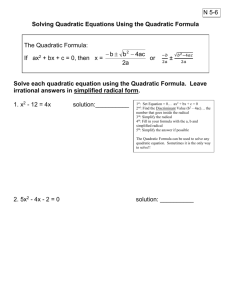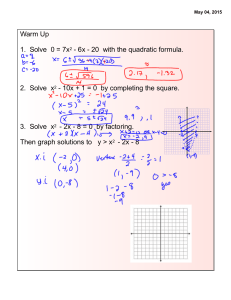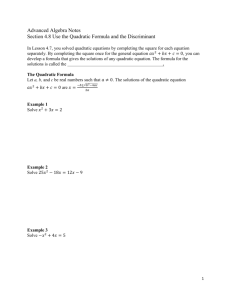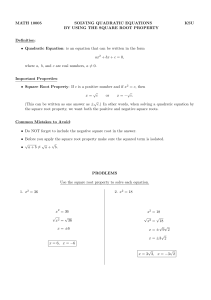Notes for 1.4 Quadratic Equations (pp. 119 – 123)
advertisement
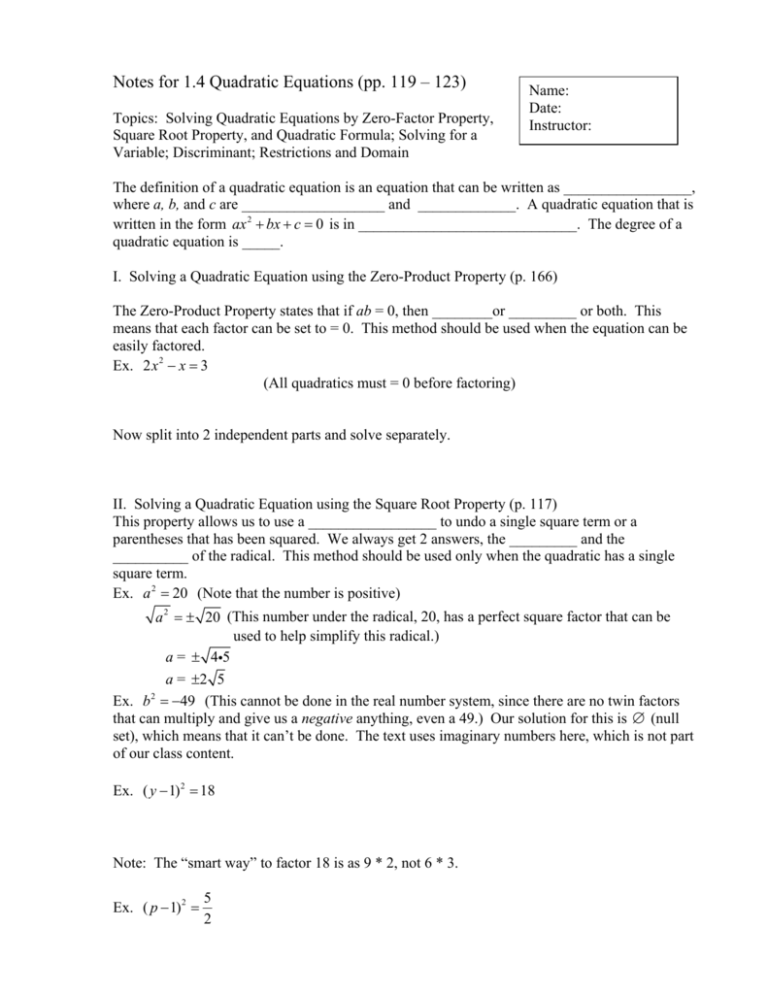
Notes for 1.4 Quadratic Equations (pp. 119 – 123) Topics: Solving Quadratic Equations by Zero-Factor Property, Square Root Property, and Quadratic Formula; Solving for a Variable; Discriminant; Restrictions and Domain Name: Date: Instructor: The definition of a quadratic equation is an equation that can be written as _________________, where a, b, and c are ___________________ and _____________. A quadratic equation that is written in the form ax 2 + bx + c = 0 is in _____________________________. The degree of a quadratic equation is _____. I. Solving a Quadratic Equation using the Zero-Product Property (p. 166) The Zero-Product Property states that if ab = 0, then ________or _________ or both. This means that each factor can be set to = 0. This method should be used when the equation can be easily factored. Ex. 2 x 2 − x = 3 (All quadratics must = 0 before factoring) Now split into 2 independent parts and solve separately. II. Solving a Quadratic Equation using the Square Root Property (p. 117) This property allows us to use a _________________ to undo a single square term or a parentheses that has been squared. We always get 2 answers, the _________ and the __________ of the radical. This method should be used only when the quadratic has a single square term. Ex. a 2 = 20 (Note that the number is positive) a 2 = ± 20 (This number under the radical, 20, has a perfect square factor that can be used to help simplify this radical.) a = ± 4i5 a = ±2 5 Ex. b = −49 (This cannot be done in the real number system, since there are no twin factors that can multiply and give us a negative anything, even a 49.) Our solution for this is ∅ (null set), which means that it can’t be done. The text uses imaginary numbers here, which is not part of our class content. 2 Ex. ( y − 1) 2 = 18 Note: The “smart way” to factor 18 is as 9 * 2, not 6 * 3. Ex. ( p − 1) 2 = 5 2 III. Solving Quadratic Equations by Completing the Square (pp. 117 – 118) Omit—there are better ways to arrive at the same answer… See below. IV. Solving Quadratic Equations by the Quadratic Formula (pp. 119 – 120) This formula is comes from the “Completing the Square” process in the general form. Memorize this: If ax 2 + bx + c = 0 and a ≠ 0 , then x = −b ± b 2 − 4ac 2a Ex. 3x 2 = 2 x − 1 (Omit) Ex. x 2 + 2 x − 7 = 0 a = ______, b = ________, c = ________ (Note that the smart way to factor 32 is 16 * 2) Ex. x3 + 8 = 0 (Omit) Study Example 5, page 120. V. Solving for a Specific Variable 1 Ex. V = π r 2 h for r. (Omit) 3 2 Ex. xy + zy + t = 0 for y (Quadratic format) VI. The Discriminant The discriminant is the portion of the quadratic formula that determines the ________________. Discriminant Number of Type of Solutions Solutions Positive, Perfect Square 2 Rational Positive, Not Perfect Squares 2 Irrational Zero 1 Double Rational ∅ Negative none Ex. Use the discriminant to determine the type of solutions of 4 x 2 − x − 3 = 0 Ex. Use the discriminant to determine the nature of the solutions of 2a 2 + 3a + 4 = 0 Note that the negative value indicates that there are no real solutions to this quadratic. Assignment: Text: pp. 123 – 125 #9, 10, 13 – 25 eoo, 26, 45 – 48, 53, 55, 57, 63, 65, 71 – 77 odd, 83



